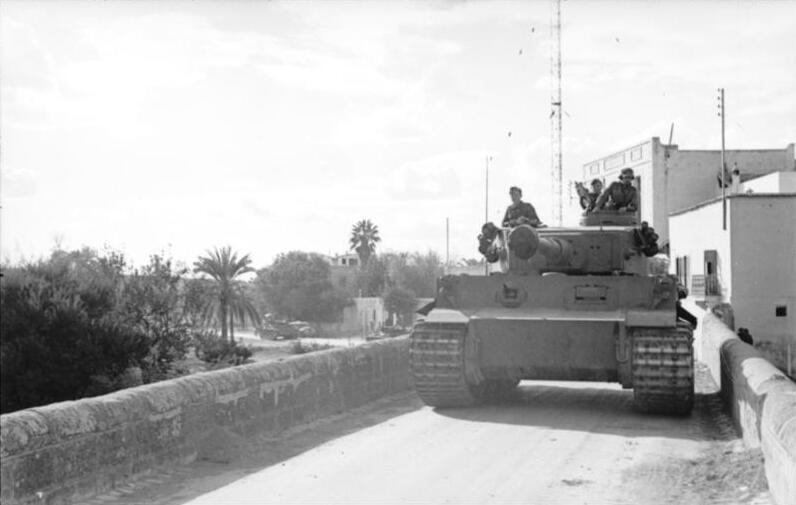I was wondering , does any one knows if there was any chance tiger’s shot against a t34 at about 400-800 hundred meters not to penetrate t34’s armor ??
Non penetrating hits would have been fairly common as any shell hitting the tank at an acute angle would have a good chance of bouncing off. This would also apply to any tank shell hitting any tank.
from my knowledge no , Tigers were capable of penetrating the front of an American M4 Sherman between 1,800 and 2,100 m (1.1 and 1.3 mi), the British Churchill IV between 1,100 and 1,700 m (0.68 and 1.1 mi), the Soviet T-34 between 100 and 1,400 m (0.062 and 0.87 mi), and the Soviet IS-2 between 100 and 300 m (0.062 and 0.19 mi). The Soviet T-34 equipped with the 76.2 mm gun could not penetrate the Tiger frontally at any range, but could achieve a side penetration at approximately 500 m firing BR-350P APCR ammunition. The T34-85’s 85 mm gun could penetrate the front of a Tiger between 200 and 500 m (0.12 and 0.31 mi),the IS-2s 122 mm gun could penetrate the front between 500 and 1,500 m (0.31 and 0.93 mi). . Also it is important what variant of T-34 was there the first models or the last T34/85 which was a good match for the Tiger with it’s 85 mm gun as you can see from the data above.
thanks for the info gentlemen !!
Interesting,I have seen quite a few of those photos in other books and publications,but there are some I haven’t seen,thanks for the tour.
Nice pictures Paladin. I got some more.
Inside turret Tiger 1.
view from gunner seat

View from loaders seat

Driver position

Cleaning the Tiger fangs…

Nice. The inside ones are views I would like to see more of.
Yup, not many pictures of it inside in spite all the “Tiger coverage” of many books and websites.
It’s something to have been able to drive looking out such a small window. You don’t realize how small until you see that picture of the drivers seat.
The interior of the Tiger doesnt look all that different from the tanks we used in the 70’s
Driver’s vision blocks offer only a limited view of the area when buttoned up. The Commander usually directs the driver as he has a better perspective of the battlefield.
Obviously one couldn’t suffer from claustrophobia in those confined spaces.
Bang on there,not much room at all!!
Excellent shots of the interior Panzerknacker,and you’re right,don’t get to see many photos of the interiors of Tigers.
[QUOTE=Panzerknacker;160086]Nice pictures Paladin. I got some more.
great pixs -inside a tiger-
Henschel.
The other two are dangereous and wacko enough but strategic nonsense.
Yes, i would also say that the Tiger 1 was (and still is) one of the best tanks around!
Unfortunately the the choice of “bigger is better” undermined all the success germany had with it’s armour. Instead they sould have opted for a more standarized design with proven equipment. Well… that is just my opinion…!
…All of us modelers are now gratefull for those pic’s…!
More pictures for modellers, this all are from the bunderarchiv collection.
76mmm hit in side turret, battle for Bielgorod ( kursk Bulge)

S.Pz.Abt 501 Tunis.

Tiger 1, panzerdivision “Gross Deutschland” France 1944.

On train, Rumania 1944.

Reloading, Battle for Bielgorod ( kursk bulge) 1943.

%2C_Munition.jpg)
Nice pictures…
It still remains a very stunning tank. And one that opens a lot of debate.
One of the most remarkable features of the tiger is its power to convince the own crew of its chances, more than any other tank. The tiger gave a psychological advantage.
It was also the only real break-through tank the germans could offer (I mean: hard hitting against hard defences, not the blitzkrieg way) while its speed was spectacular compared to the “light” pz III and IV. The Tiger II was to slow (eventually halted when out of fuel) and the Panther (at least panther I) was a bit to thin on the sides and of course way to late…
Yet I stay convinced that to many were produced in the event or in other words: production halted to late (should’ve stopped when Panther was rolling smooth - autumn 1943). Some Panther could’ve been easily uparmored and given the Flak 88 to act as “new Tigers” for a reduced cost and same speed. The side armor and 88 had a better soft target factor: hitting against pillboxes and infantry nests.
The Tiger was in fact the German KV I (aside the weaker T34’s): a very big fear factor, useful, but at the end it was to be put aside for let’s say an up to date T34/85.

